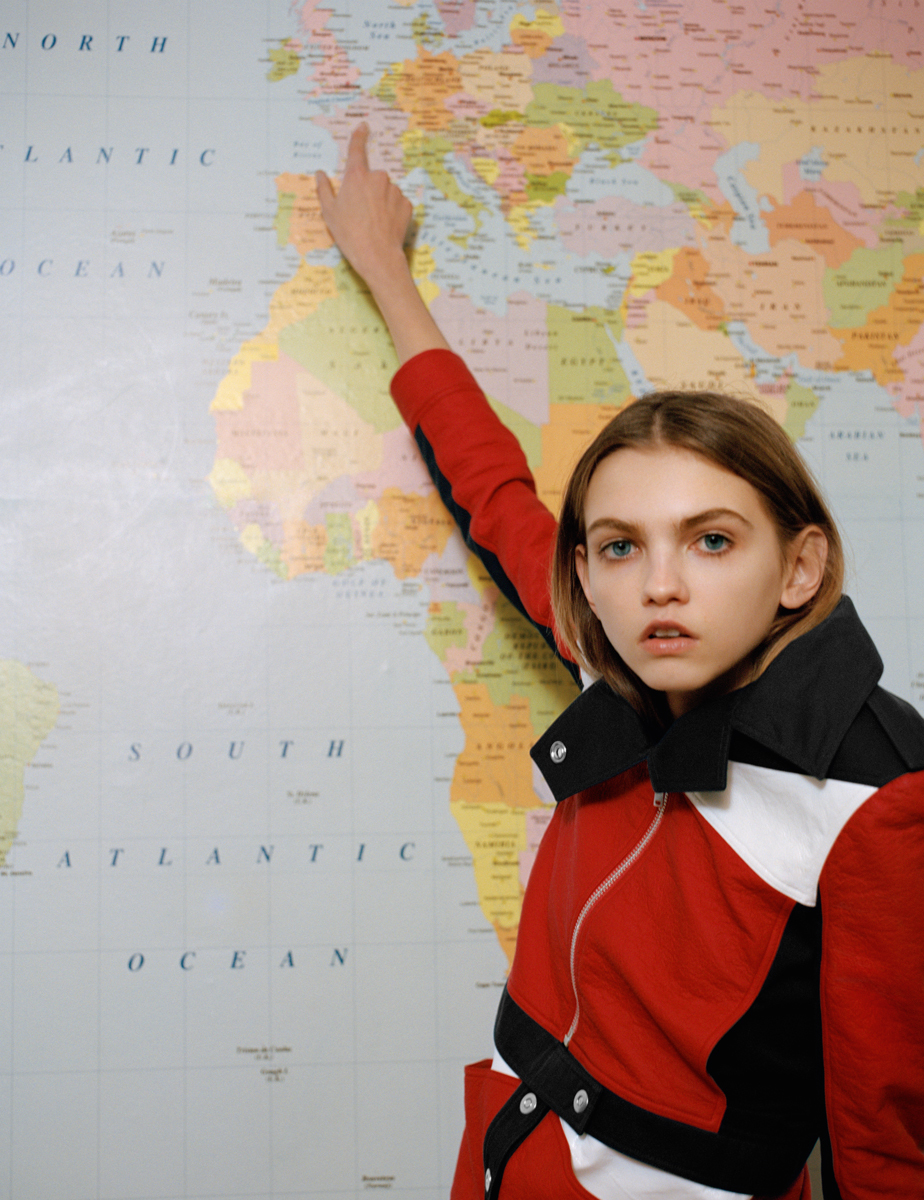Fronted by new creative directors Arnaud Vaillant and Sébastien Meyer, Courrèges, the futuristic Parisian label from the 60s once famous for “making mothers want to dress like their daughters” is developing a new sense of Gallic youthfulness. Take their first collection for the brand, presented during the spring/summer 16 shows in Paris where only one item was presented on each model, on a simple ribbed bodysuit. With fifteen revisited Courrèges classics (including miniskirts and biker-ish blousons) in fifteen variations, the designers proposed a twisted bourgeois uniform open to the most radical re-appropriations: “Our vision of elegance is a philosophy and a sense of freedom rather than a singular kind of style aimed at a niche market,” Vaillant declares, as he sips lurid green Menthe à l’eau (a classic French drink favored by children in the pre-Coca Cola days). Reclining on a plush velvet couch in L’Avenue — the swanky café in the heart of Parisian luxury, Avenue Montaigne, where Maison Courrèges is also based — they create a somewhat striking contrast, like something out of a Nouvelle Vague film.
Both designers were raised in the South of France, and they know a thing or two about being outsiders in the notoriously snobbish French capital. “Dreaming of Paris from afar makes you love it more. You notice things locals take for granted: the tiny bit of madness in all the Parisiennes, their effortless decadence, their cool, their culture,” Meyer says. (They now reside in the chic Saint Germain, long deserted by local bobos in favor of gentrified outskirts.) The pair met at the Paris fashion school Mod’Art, and Vaillant served as a visual merchandiser for Chanel and Balenciaga before they founded the label Coperni in 2013. Derived from Prussian astronomer Copernicus, it was a tongue-in-cheek way of indicating their love of futuristic lines and a mathematical rigor — an uncanny premonition of things to come considering their latest calling.
The brand was quickly noticed for its minimalist but refined garçonne chic paired with an acute sense of wearability, which stands out in a current climate of sporty luxe. With recurring items such as cropped A-line skirts and skinny trousers, the boys already seemed to be treading in the footsteps of André Courrèges and success wasn’t long underway. Only a year after the launch of Coperni, it earned them the ANDAM Award. A year on, after being nominated for the LVMH Prize in 2015, they were snapped up by Courrèges, forcing them to pull out of the award and put the promising brand on hiatus. “Things have gone incredibly fast, and it felt like the right thing because Courrèges is so close to our DNA. It’s a very natural, organic continuation of it, but at a scale we wouldn’t have been able to reach on our own,” Meyer says.
As for the re-launch of the 60s cult brand, the timing was pretty perfect: not only had France been busy breathing new life into heritage labels such as Moynat, Schiaparelli, and Vionnet, creating a mood for revivals, but at Louis Vuitton, Nicholas Ghesquière’s early-70s spirit was setting a tone in fashion that fit perfectly with what Courrèges stood for. Making the old house a viable business brand, however, would take more than being at the right time at the right place. “When you find yourself faced with such a weighty history, you can’t quote it too literally. You have to rethink how its philosophy translates into a modern context,” Vaillant says, referring, for instance, to Courrèges’ use of white in his early collections, which coincided with the introduction of the home washing machine. “The future is inevitably a reflection of the current climate,” Meyer adds.
Indeed, the strength of Meyer and Vaillant’s vision isn’t simply the reflection of what André Courrèges stood for at the time, but trying to imagine what the founder would have done if he’d been designing in 2016. (He died on January 8 this year, at the age of 92.) For their debut collection, this notion materialized in laser-cuts and high-tech fabrics, something they’re currently exploring and looking to expand; kimono cuts with cassures (fractures in the fabric) to allow for easy and ceaseless folding; or skirts composed of two circles of canvas bordered by snap fasteners. In other words, while it is clearly futuristic, the new Courrèges is tackling a much closer future: “Futurism needn’t mean science fiction: it could just be about next year,” Vaillant says. It has translated into a collection that isn’t visually high tech, but feels strongly about proposing new needs for new lifestyles. Commerce paired with stylish, practical solutions? Could this be the future?
Credits
Text Alice Pfeiffer
Photography Letty Schmiterlow
Styling Max Clark
Hair Kiyoko Odo using Bumble and Bumble
Make-up Ciara O’Shea at LGA Management using YSL Beauté
Production Julie Velut at Artistry London
Photography assistance Yi Chen, Scott Gallagher
Styling assistance Bojana Kozarevic, Louis Prier-Tisdall
Printed by Luke at Touch
Model Molly Bair at Elite
Molly wears jacket Courrèges
